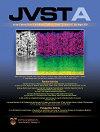高质量金属离子辐照可以在元素靶上生长高熵亚晶格氮化薄膜
IF 2.1
3区 材料科学
Q3 MATERIALS SCIENCE, COATINGS & FILMS
引用次数: 0
摘要
利用磁控溅射技术合成高熵亚晶格氮化物(HESN)涂层通常使用具有特定元素组成的定制合金靶。这种方法是昂贵的,需要很长的交付时间,并提供非常有限的灵活性来调整薄膜成分。在这里,我们展示了一种生长HESN薄膜的新方法,该方法依赖于排列在多阴极结构中的元素靶,在沉积过程中衬底旋转。利用Ti、V、Nb和Mo靶材在直流磁控溅射模式下生长,在温度为~ 520°С的条件下生长,而W靶材则由高功率脉冲磁控溅射(HiPIMS)操作,提供重离子源。通过改变衬底偏置脉冲Vs的振幅,将金属离子EW+的能量控制在80 ~ 620 eV的范围内,并与HiPIMS脉冲的富金属离子相位同步。我们证明了W+辐照在近表面原子层中提供了成膜组分的动态反冲混合。当EW+≥320 eV时,这种沉积几何结构固有的多层形成现象被抑制,因此得到了成分均匀的HESN薄膜,这一点得到了显微组织和元素分析的证实。本文章由计算机程序翻译,如有差异,请以英文原文为准。
High-mass metal ion irradiation enables growth of high-entropy sublattice nitride thin films from elemental targets
Synthesis of high-entropy sublattice nitride (HESN) coatings by magnetron sputtering is typically done using custom-made alloyed targets with specific elemental compositions. This approach is expensive, requires long delivery times, and offers very limited flexibility to adjust the film composition. Here, we demonstrate a new method to grow HESN films, which relies on elemental targets arranged in the multicathode configuration with substrates rotating during deposition. TiVNbMoWN films are grown at a temperature of ∼520 °С using Ti, V, Nb, and Mo targets operating in the direct current magnetron sputtering mode, while the W target, operated by high power impulse magnetron sputtering (HiPIMS), provides a source of heavy ions. The energy of the metal ions EW+ is controlled in the range from 80 to 620 eV by varying the amplitude of the substrate bias pulses Vs, synchronized with the metal-ion-rich phase of HiPIMS pulses. We demonstrate that W+ irradiation provides dynamic recoil mixing of the film-forming components in the near-surface atomic layers. For EW+ ≥ 320 eV the multilayer formation phenomena, inherent for this deposition geometry, are suppressed and, hence, compositionally uniform HESN films are obtained, as confirmed by the microstructural and elemental analysis.
求助全文
通过发布文献求助,成功后即可免费获取论文全文。
去求助
来源期刊

Journal of Vacuum Science & Technology A
工程技术-材料科学:膜
CiteScore
5.10
自引率
10.30%
发文量
247
审稿时长
2.1 months
期刊介绍:
Journal of Vacuum Science & Technology A publishes reports of original research, letters, and review articles that focus on fundamental scientific understanding of interfaces, surfaces, plasmas and thin films and on using this understanding to advance the state-of-the-art in various technological applications.
 求助内容:
求助内容: 应助结果提醒方式:
应助结果提醒方式:


